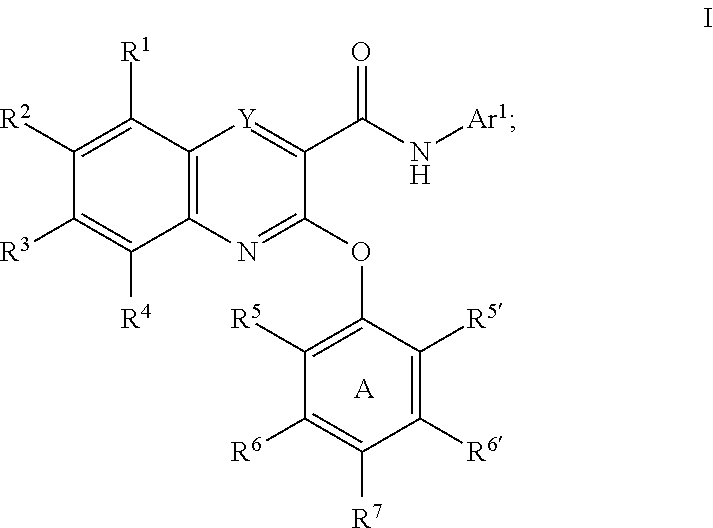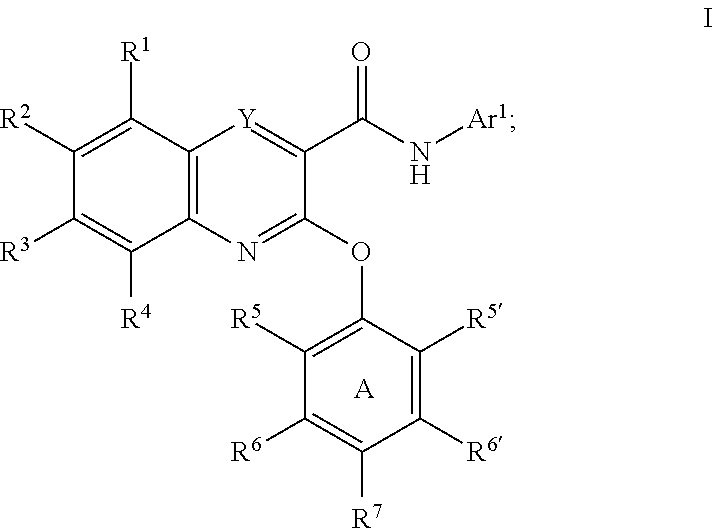Substituted quinoxalines as sodium channel modulators
a sodium channel modulator and substituted quinoxaline technology, applied in the field of compounds, can solve the problems of poor therapeutic window of v /sub>inhibitors
- Summary
- Abstract
- Description
- Claims
- Application Information
AI Technical Summary
Benefits of technology
Problems solved by technology
Method used
Image
Examples
example 1
Preparation of 5-(3-(2,4-dimethoxyphenoxy)quinoxaline-2-carboxamido)picolinic acid (26)
[1061]
[1062]To 3-hydroxyquinoxaline-2-carboxylic acid (10.94 g, 57.53 mmol) was added thionyl chloride (109.1 mL, 1496 mmol) and DMF (35 drops) and the reaction was refluxed at 80° C. for 17 hours. The excess thionyl chloride and N,N-dimethyl formamide were removed in vacuo to yield 3-chloroquinoxaline-2-carbonyl chloride (13 g, 99%) as a brown solid. 1H NMR (400 MHz, DMSO-d6) δ 8.27-8.18 (m, 1H), 8.18-8.09 (m, 1H), 8.09-7.93 (m, 2H) ppm.
[1063]A solution of 3-chloroquinoxaline-2-carbonyl chloride (3.5 g, 15.45 mmol) in dichloromethane (32.3 mL) was added dropwise to a mixture of methyl 5-aminopyridine-2-carboxylate (2.35 g, 15.45 mmol), pyridine (3.75 mL, 46.35 mmol) and dichloromethane (48.38 mL) at 0° C. The mixture was stirred and allowed to warm up to room temperature overnight. To the reaction, water (40 mL) was added and the product precipitated. The solid was isolated by filtration, washed ...
example 2
Preparation of 5-(3-(4-fluoro-2-methoxyphenoxy)quinoxaline-2-carboxamido)picolinic acid (32)
[1067]
[1068]A mixture of ethyl 3-chloroquinoxaline-2-carboxylate (300 mg, 1.27 mmol), 4-fluoro-2-methoxy-phenol (289.0 μL, 2.54 mmol) and Cs2CO3 (826.3 mg, 2.54 mmol) in NMP (3.0 mL) was stirred at 100° C. for 3 hours. The reaction mixture was poured into water, the pH was adjusted to pH 6 with 1N HCl and the mixture was extracted with ethyl acetate (3×). The organics were combined, washed with brine, dried over Na2SO4 and evaporated to dryness. Purification by column chromatography using a gradient of MeOH in dichloromethane (0-10%) gave 3-(4-fluoro-2-methoxy-phenoxy)quinoxaline-2-carboxylic acid (360 mg, 90%) as a red oil. ESI-MS m / z calc. 314.07, found 315.1 (M+1)+; Retention time: 1.35 minutes (3 minutes run).
[1069]A solution of the 5-aminopicolinic acid methyl ester (15.2 mg, 0.1 mmol), 3-(4-fluoro-2-methoxy-phenoxy)quinoxaline-2-carboxylic acid (34.57 mg, 0.11 mmol), N-methylmorpholine ...
example 3
Preparation of 5-(2-(2-chloro-4-fluorophenoxy)quinoline-3-carboxamido)picolinic acid (79)
[1070]
[1071]A solution of 2-chloroquinoline-3-carbonyl chloride (2.72 g, 12.04 mmol) in methylene chloride (37.7 mL) was added dropwise to a mixture of methyl 5-aminopyridine-2-carboxylate (1.83 g, 12.04 mmol), pyridine (2.9 mL, 36.12 mmol) and methylene chloride (25.1 mL) at 0° C. The mixture was stirred and allowed to warm up to room temperature over 1.5 hours. To the reaction slurry, water (30 mL) was added and a precipitate formed. The solid was filtered, washed with water (2×30 mL), hexanes (2×50 mL), and a small amount of dichloromethane. The solid from the filtrate was isolated and washed with water (1×15 mL) and hexanes (1×20 mL). This solid obtained was dried in the vacuum oven to yield methyl 5-(2-chloroquinoline-3-carboxamido)picolinate (3 g, 73%). ESI-MS m / z calc. 341.06, found 342.2 (M+1)+; Retention time: 1.18 minutes (3 minutes run). 1H NMR (400 MHz, DMSO-d6) δ 11.36 (s, 1H), 8.95...
PUM
| Property | Measurement | Unit |
|---|---|---|
| temperature | aaaaa | aaaaa |
| temperature | aaaaa | aaaaa |
| pH | aaaaa | aaaaa |
Abstract
Description
Claims
Application Information
 Login to View More
Login to View More - R&D
- Intellectual Property
- Life Sciences
- Materials
- Tech Scout
- Unparalleled Data Quality
- Higher Quality Content
- 60% Fewer Hallucinations
Browse by: Latest US Patents, China's latest patents, Technical Efficacy Thesaurus, Application Domain, Technology Topic, Popular Technical Reports.
© 2025 PatSnap. All rights reserved.Legal|Privacy policy|Modern Slavery Act Transparency Statement|Sitemap|About US| Contact US: help@patsnap.com



